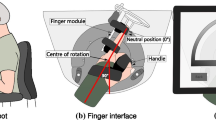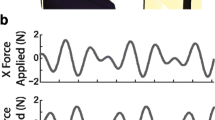Abstract
This article presents a novel evaluation system along with methods to evaluate bilateral coordination of arm function on activities of daily living tasks before and after robot-assisted therapy. An affordable bilateral assessment system (BiAS) consisting of two mini-passive measuring units modeled as three degree of freedom robots is described. The process for evaluating functional tasks using the BiAS is presented and we demonstrate its ability to measure wrist kinematic trajectories. Three metrics, phase difference, movement overlap, and task completion time, are used to evaluate the BiAS system on a bilateral symmetric (bi-drink) and a bilateral asymmetric (bi-pour) functional task. Wrist position and velocity trajectories are evaluated using these metrics to provide insight into temporal and spatial bilateral deficits after stroke. The BiAS system quantified movements of the wrists during functional tasks and detected differences in impaired and unimpaired arm movements. Case studies showed that stroke patients compared to healthy subjects move slower and are less likely to use their arm simultaneously even when the functional task requires simultaneous movement. After robot-assisted therapy, interlimb coordination spatial deficits moved toward normal coordination on functional tasks.






Similar content being viewed by others
References
Braddom R (2003) Handbook of physical medicine and rehabilitation. Saunders, Philadelphia
Burgar CG, Lum PS, Shor PC, Van der Loos HFM (2000) Development of robots for rehabilitation therapy: the Palo Alto VA/Stanford experience. J Rehabil Res Dev 37(6):663–674
Cauraugh J, Summers J (2005) Neural plasticity and bilateral movements: a rehabilitation approach for chronic stroke. Prog Neurobiol 75:309–320
Cirstea MC, Levin MF (2000) Compensatory strategies for reaching in stroke. Brain 123(5):940–953
Craig JJ (2004) Introduction to robotics: mechanics and control, 3rd edn. Pearson Prentice Hall, Upper Saddle River
Cramer SC (2010) Brain repair after stroke. N Engl J Med 362:1784–1787
Dipietro L, Krebs HI, Fasoli SE, Volpe BT, Hogan N (2009) Submovement changes characterize generalization of motor recovery after stroke. Cortex 45(3):318–324
Duncan PW, Zorowitz R, Bates B, Choi JY, Glasberg JJ, Graham GD, Katz RC, Lamberty K, Reker D (2011) Management of adult stroke rehabilitation care: a clinical practice guideline. Stroke 36(9):e100–e143
Fugl-Meyer AR, Jaasko L, Leyman I, Olsson S, Steglind S (1975) The post-stroke hemiplegic patient. A method for evaluation of physical performance. Scand J Rehabil Med 7:13–31
Harris-Love ML, McCombe Waller S, Whitall J (2005) Exploiting interlimb coupling to improve paretic arm reaching performance in people with chronic stroke. Arch Phys Med Rehabil 86(11):2131–2137
Hseih Y, Wu C, Liao W, Lin K, Wu K, Lee C (2011) Effects of treatment intensity in upper limb robot-assisted therapy for chronic stroke: a pilot randomized controlled trial. Neurorehabil Neural Repair 25(6):503–511
Hung YC, Charles J, Gordon AM (2004) Bimanual coordination during a goal-directed task in children with hemiplegic cerebral palsy. Dev Med Child Neurol 46(11):746–753
Johnson MJ, Wisneski KJ, Anderson J, Nathan D, Smith RO (2006) Development of ADLER: the activities of daily living exercise robot. In: IEEE-RAS Biomedical Robotics (BIOROB). Pisa, pp 881–886
Johnson MJ, Wisneski K, Anderson J, Nathan DE, Strachota E, Kosaish J, Johnston J, Smith RO (2007) Task-oriented and purposeful robot-assisted therapy. In: Lazinica A (ed) Rehabilitation robotics. Int J Adv Robotics Syst. Vienna. pp 222–242
Kamper DG, McKenna-Cole AN, Kahn LE, Reinkensmeyer DJ (2002) Alterations in reaching after stroke and their relation to movement direction and impairment severity. Arch Phys Med Rehabil 83(5):702–707
Kazennikov O, Perrig S, Wiesendanger M (2002) Kinematics of a coordinated goal-directed bimanual task. Behav Brain Res 134:83–91
Kwakkel G, Kollen BJ, Krebs HI (2008) Effects of robot-assisted therapy on upper limb recovery after stroke: a systematic review. Neurorehabil Neural Repair 22(2):111–121
Levin MF (1996) Interjoint coordination during pointing movements is disrupted in spastic hemiparesis. Brain 119(1):281–293
Lewis GN, Byblow WD (2004) Bimanual coordination dynamics in post-stroke hemiparetics. J Mot Behav 36(2):174–188
Lo AC, Guarino P, Richards LG, Haselkorn JK, Wittenberg GF, Federman DG, Ringer RJ, Wagner TH, Krebs HI, Volpe BT, Bever CT Jr, Bravata DM, Duncan PW, Corn BH, Maffucci AD, Nadeau SE, Conroy SS, Powell JM, Huang GD, Peduzzi P (2010) Robot-assisted therapy for long-term upper-limb impairment after stroke. N Engl J Med 362:1772–1783
Loureiro R, Amirabdollahian F, Topping M, Driessen B, Harwin W (2004) Upper limb robot mediated stroke therapy—GENTLE/s approach. J Auton Robots 15(1):35–51
Lum PS, Burgar CG, Shor PS, Majumudar M, Van der Loos M (2002) Robot-assisted movement training compared with conventional therapy techniques for the rehabilitation of upper-limb motor function after stroke. Arch Phys Med Rehabil 83:952–959
McCombe WS, Harris-Love M, Liu W, Whitall J (2006) Temporal coordination of the arms during bilateral simultaneous and sequential movements in patients with chronic hemiparesis. Exp Brain Res 168:450–454
McCombe WS, Liu W, Whitall J (2008) Temporal and spatial control following bilateral versus unilateral training. Hum Mov Sci 27(5):749–758
Nathan DE, Johnson MJ, McGuire JM (2009) Design and validation of a low-cost assistive glove for assessment and therapy of the hand during ADL-focused robotic stroke therapy. J Rehabil Res Dev 46(5):587–602
Portney LG, Watkins MP (2008) Foundations of clinical research: applications to practice, vol 3rd. Prentice Hall Health, New Jersey
Radomski MV, Trombly CA (2001) Occupational therapy for physical dysfunction, 5th edn. Lippincott Williams & Wilkins, Philadelphia
Rohrer B, Fasoli S, Krebs HI, Hughes R, Volpe B, Frontera WR, Stein J, Hogan N (2002) Movement smoothness changes during stroke recovery. J Neurosci 22(18):8297–8304
Serrien DJ, Wiesendanger M (2000) Temporal control of a bimanual task in patients with cerebellar dysfunction. Neuropsychologia 38:558–565
Spencer JRM, Zelaznik HN, Diedrichsen J, Ivry RB (2003) Disrupted timing of discontinuous but not continuous movements by cerebellar lesions. Science 300(5624):1437–1439
Steenbergen B, van Thiel E, Hulstijn W, Meulenbroek RGJ (2000) The coordination of reaching and grasping in sptastic hemiparesis. Hum Mov Sci 19:75–105
Stewart KC, Cauraugh JH, Summers JJ (2006) Bilateral movement training and stroke rehabilitation: a systematic review and meta-analysis. J Neurol Sci 244:89–95
Wang S, Johnson MJ (2007) Methods for evaluating interlimb coordination for bimanual robotic therapy after stroke. In: IEEE-International Conference on Rehabiliation Robotics (ICORR), Noordwijk, pp 438–445
Whitall J, McCombe Waller S, Silver K, Macko RF (2000) Repetitive bilateral arm training with rhythmic auditory curing improves motor function in chronic hemiparetic stroke. Stroke 31:2390–2395
Wilson DJ, Baker LL, Craddock JA (1984) Functional test for the hemiparetic upper extremity. Am J Occup Ther 38(3):159–164
Wisneski KJ, Johnson MJ (2007) Quantifying kinematics of purposeful movements to real, imagined, or absent functional objects: implications for modelling trajectories for robot-mediated ADL tasks. J Neuroeng Rehabil 4:7
Wu C, Trombly A, Lin K et al (2000) A kinematic study of contextual effects on reaching performance in persons with and without stroke: influences of object availability. Arch Phys Med Rehabil 81:95–101
Acknowledgments
This study is supported in part by the National Institutes of Health—NINDS 5K25NS058577-03, Advancing a Healthier Wisconsin Grant #5520015 and the Medical College of Wisconsin Research Affairs Committee Grant# 3303017. We would like to acknowledge that this material is the result of work supported with resources and the use of facilities at the Clement J. Zablocki VA medical center, Milwaukee WI. We would also like to thank Rubing Xu, Rohit Ruparel, Dr Yasser Mallick for their assistance in recruitment and collecting the data. We would like to thank Rui Loureiro, PhD and William Harwin, PhD at the University of Reading Cybernetics department for their role in designing the tracker.
Author information
Authors and Affiliations
Corresponding author
Appendix
Appendix
The coefficients of the six voltage conversion Eqs. 1 and 2 are given in Table 4.
1.1 Dynamic accuracy details
The trackers were attached to the robot end-effector and moved along eight trajectories; the adjusted forward kinematics equations were used to calculate corresponding position trajectories. The difference between the measured and reference trajectories were calculated over the constant velocity segments within the trajectory and then averaged across all samples; there were approximately 250 samples. Table 5 shows that the best accuracy was seen in the X coordinate for all speeds. The differences in positions were not significant (P = 0.62).
Rights and permissions
About this article
Cite this article
Johnson, M.J., Wang, S., Bai, P. et al. Bilateral assessment of functional tasks for robot-assisted therapy applications. Med Biol Eng Comput 49, 1157–1171 (2011). https://doi.org/10.1007/s11517-011-0817-0
Received:
Accepted:
Published:
Issue Date:
DOI: https://doi.org/10.1007/s11517-011-0817-0




